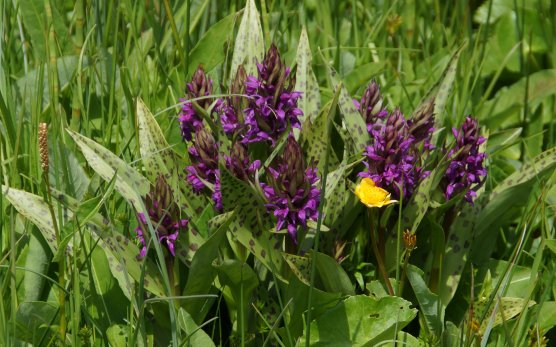
Development of a habitat network for the Violet Copper

Also to be found in the Northern Eifel - the German orchid of the year 2020
December 06, 2019
The Orchid can be recognised by its purple-red inflorescences and the spotted leaves with entire margins, wide at the base and pointed towards their end.
On the Red List in NRW it is considered "endangered", but thanks to ongoing nature conservation measures less critical than other species (category 3N). But it also belongs to the "Species with special responsibility for Germany"! A very high proportion of the world population occurs in Germany. If we lose it in our country, it is threatened with extinction globally.
The habitats of the species are wet moorland grasslands in the area of springs and in the alluvial plain. Such biotopes are hardly usable for agriculture. They should be spared as far as possible from drainage, from trampling through excessive keeping of livestock and fertilization of any kind.
LIFE "Patches & Corridors" has a high interest in preserving these habitats. Simultaneously, they are important for the Violet Copper (Lycaena helle), our flagship species. The butterfly finds nectar plants here and the females can lay eggs on Bistort (Bistorta officinalis), which also grows here. All three species, Broad-leaved Marsh Orchid, Bistort and Violet Copper are part of the same biocoenosis.
Characteristic: The species of the genus Dactylorhiza are "nectar-deception-flowers. The individual flowers have a spur, which usually contains nectar in other plant species. However, this is not the case with the Broad-leaved Marsh Orchid. Insects are nevertheless attracted by the blossom and on approach strip off pollen that sticks to the insect. At the same time, the stigma is exposed so that the plant is ready to be fertilized by the next deceived insect.


